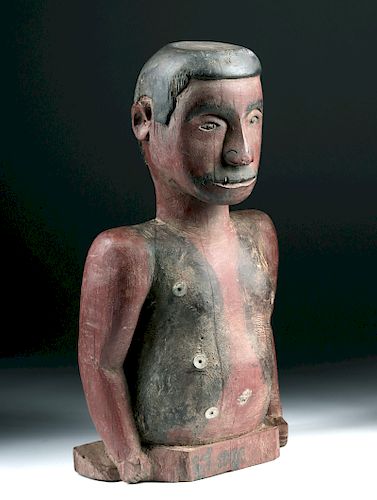20th C. Southeast Asian Wood Bust w/ French Coins
Lot 177a
About Seller
Artemis Gallery
686 S Taylor Ave, Ste 106
Louisville, CO 80027
United States
Selling antiquities, ancient and ethnographic art online since 1993, Artemis Gallery specializes in Classical Antiquities (Egyptian, Greek, Roman, Near Eastern), Asian, Pre-Columbian, African / Tribal / Oceanographic art. Our extensive inventory includes pottery, stone, metal, wood, glass and textil...Read more
Categories
Estimate:
$800 - $1,200
Absentee vs Live bid
Two ways to bid:
- Leave a max absentee bid and the platform will bid on your behalf up to your maximum bid during the live auction.
- Bid live during the auction and your bids will be submitted real-time to the auctioneer.
Bid Increments
| Price | Bid Increment |
|---|---|
| $0 | $25 |
| $300 | $50 |
| $1,000 | $100 |
| $2,000 | $250 |
| $5,000 | $500 |
| $10,000 | $1,000 |
| $20,000 | $2,500 |
| $50,000 | $5,000 |
| $100,000 | $10,000 |
| $200,000 | $20,000 |
About Auction
By Artemis Gallery
Jan 7, 2020
Set Reminder
2020-01-07 10:00:00
2020-01-07 10:00:00
America/New_York
Bidsquare
Bidsquare : VARIETY AUCTION - Antiquities / Ethnographic
https://www.bidsquare.com/auctions/artemis-gallery/variety-auction---antiquities-ethnographic-4787
Around the world & back in time - be amazed at the treasures you will find. Antiquities from Egypt, Greece, Italy and the Near East, Asian, Pre-Columbian, African / Tribal / Oceanic, Native American, Spanish Colonial, Russian Icons, Fine Art, much more! Artemis Gallery info@artemisgallery.com
Around the world & back in time - be amazed at the treasures you will find. Antiquities from Egypt, Greece, Italy and the Near East, Asian, Pre-Columbian, African / Tribal / Oceanic, Native American, Spanish Colonial, Russian Icons, Fine Art, much more! Artemis Gallery info@artemisgallery.com
- Lot Description
**Originally Listed At $400**
Southeast Asia, French Indochina, Vietnam, Laos, or Cambodia, ca. early to mid 20th century CE. A hand-carved wooden bust depicting a man of status, perhaps a chief or a wealthy man, wearing a black-painted vest atop his red body. The man holds his arms at his sides with hands placed next to the integral plinth, and the painted vest is adorned with four 1943 French Indochina 1 centime coins. The raised head boasts almond-shaped eyes, a broad nose with incised nostrils, cupped ears, and thin lips with a drilled slot meant to hold a cigarette or pipe. A faded date on the bottom of the plinth appears to read "1881," perhaps the birth date of this individual, however fading has rendered the numbers difficult to discern. Size: 12.5" W x 21.75" H (31.8 cm x 55.2 cm).
The sculpture exhibits a very unusual coalescence of styles. The proportions of the carved details - including those of the head and torso, small hands, and painted mustache - indicate this bust represents a "big man," or chief from a tribal society, likely one of the hill tribes or ethnic minority groups in Indochina. However, the short-cropped style of the coiffure as well as the buttoned vest suggests heavy influence by French colonists. It is possibly that this bust was part of a tribal funerary shrine, and the European stylistic influences suggest the figure was in some form connected to the colonial authorities.
Provenance: private Johnson collection, Los Angeles, California, USA
All items legal to buy/sell under U.S. Statute covering cultural patrimony Code 2600, CHAPTER 14, and are guaranteed to be as described or your money back.
A Certificate of Authenticity will accompany all winning bids.
We ship worldwide and handle all shipping in-house for your convenience.
#147516Coins on vest were perhaps added later. Losses and insect damage to verso as shown. Nicks and abrasions to arms, body, head, plinth, and verso, with fading to some areas of original pigmentation, softening to some finer details of bust and coins, light encrustations, and inactive insect damage. Nice earthen deposits and traces of original pigmentation throughout.Condition
- Shipping Info
-
All shipping is handled in-house for your convenience. Your invoice from Artemis Gallery will include shipping calculation instructions. If in doubt, please inquire BEFORE bidding for estimated shipping costs for individual items.
-
- Buyer's Premium



 EUR
EUR CAD
CAD AUD
AUD GBP
GBP MXN
MXN HKD
HKD CNY
CNY MYR
MYR SEK
SEK SGD
SGD CHF
CHF THB
THB















